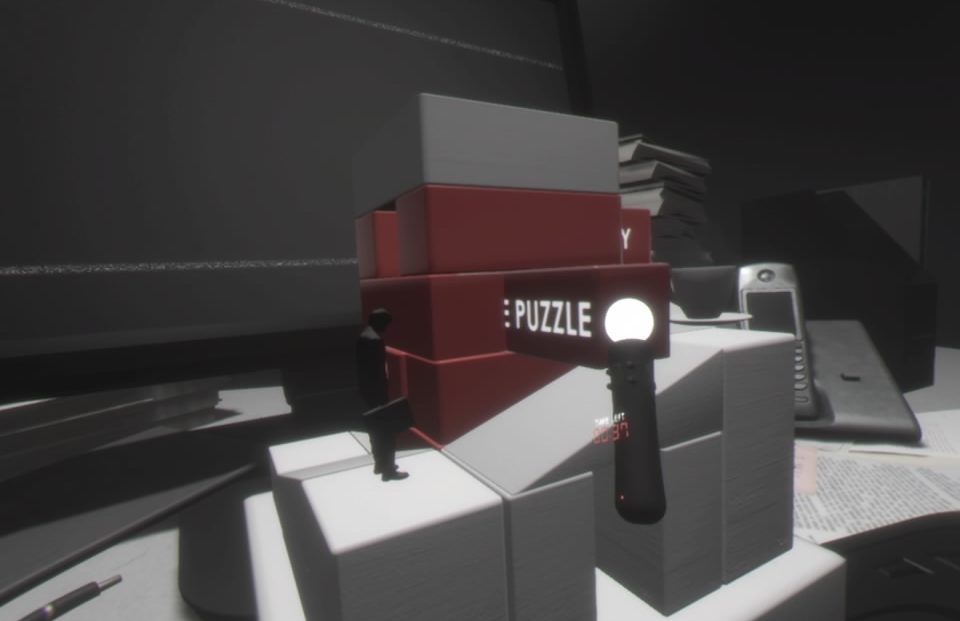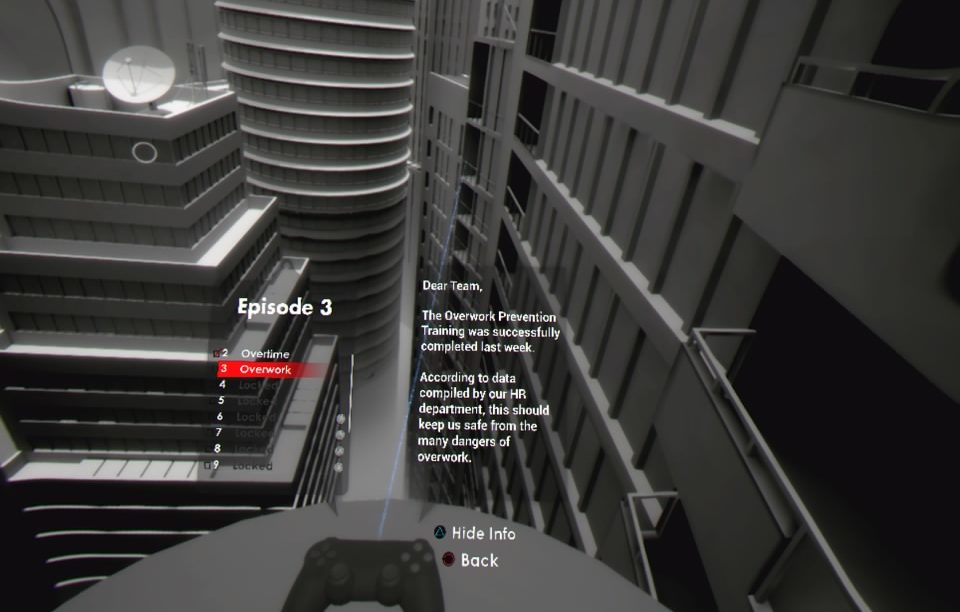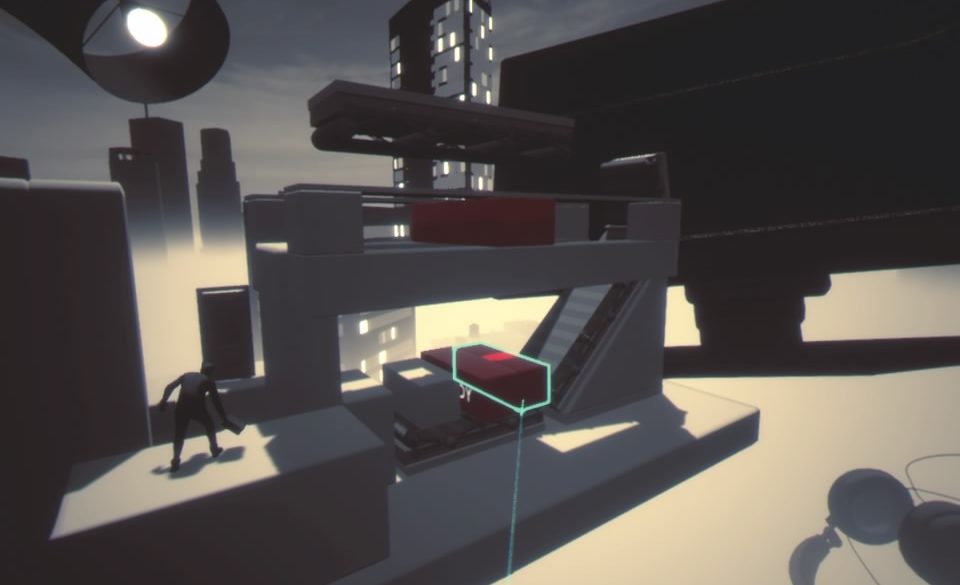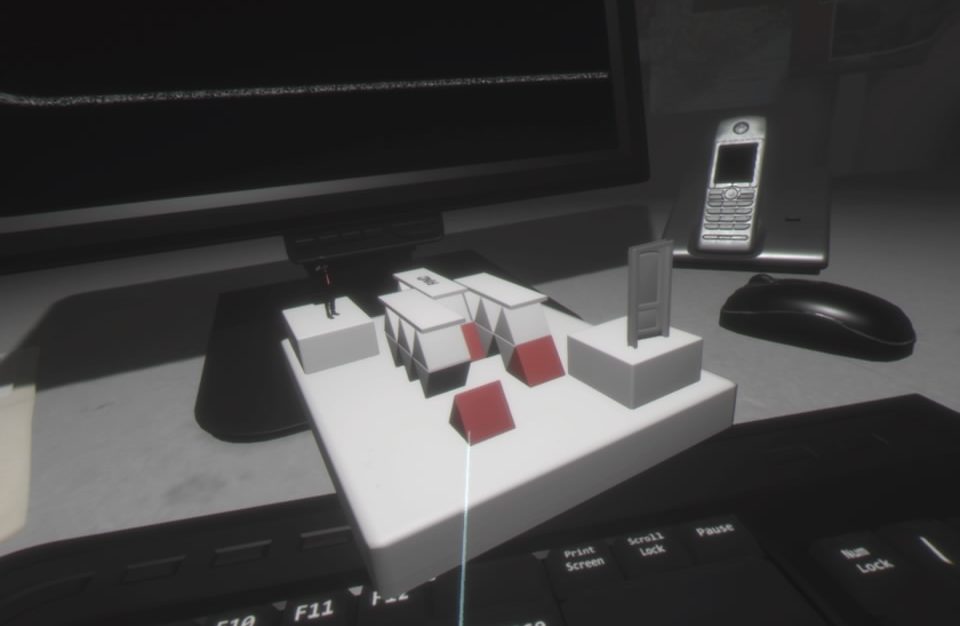Developer / Publisher – Red Accent Studios / Oasis Games
Price – US $19.99 / EU €19.99 / UK £15.99 / AU $26.95
Release Date – May 22, 2018
Control Method – DS4, 1x Move Controllers
Play Type – Sitting
Pro Patch – No
Digital Only – Yes
Reviewed on – PS4 Pro
Salary Man, Salary Man, does whatever a Salary….man…..can? Alright, that doesn’t quite work, but Salary Man the VR puzzle game does…most of the time! The purpose of this game is to move obstacles out of the way, creating a path for your little worker man to get to a door, which ends the stage. It’s a simple concept that, like most great puzzle games, is used to solve complex puzzle and offers a lot challenge and some dark humor targeting just how many of us 9 to 5ers live our lives.
You are going to need 1 move controller or DS4 and the controls here, like many great puzzle games, are simple. Each level is made up of grey and red blocks with the red ones being the ones you can manipulate. Like the table top game Jenga, you just slide them in or out of position allowing portions of the environment to fall in place, creating a path for the silhouetted, briefcase toting worker to run through and get to the door at the end of the stage. Each stage is timed, and should you fail to solve that puzzle in the allotted amount of time, you lose. The move controller allows you a little more freedom as you need to physically grab the blocks you want to move by touching the controller to the block whereas the DS4 acts as a wand, allowing you to steer the laser coming out of the top of it to highlight the blocks. Maneuvering the stage to change your view of the puzzle is easier with the move as you just drag the stage where you want it to go. DS4 on the other hand has assigned the direction you move the stage to the face buttons, but in reverse order so left is right and up is down. I have no idea why they chose those options but while I used the DS4, I could never wrap my brain around the reverse controls forcing way to many level adjustments. Between the 2 controls, the Move is probably the way to go, but the control with the DS4 (minus the way you move the stage) allows for slightly tighter block manipulation and gave me a few more intricate and level saving moments. Try them both, see which one appeals to your more.
Salary Man looks alright, if not a bit bland. Stages are cast in a grey scale color scheme with the only color being on the blocks you can manipulate. The level selection screen is a cityscape, while the actual puzzles take place over top of a gigantic office desk or floating in the sky with some objects drifting in the background. The shapes you can move come in a variety as you progress through the near 80 stages and of course, as you make way through the levels, they only get more elaborate and introduce new elements like scales, conveyor belts and enemies to avoid. Every stage is titled with some kind of office theme and is prefaced by some scrolling text reminding you of just how unimportant you are to the company…you have no identity, you are just a number in a long line of numbers are expected to just take it and fall in line.
The soundtrack has been ripped right from the 80’s, but not the 80’s many of us know. Instead the game has decided to visit the Japanese 80’s pop scene with some damn catchy songs that I have never heard of before. It is a really odd choice that works, if not just because the music just sticks in your head. Full disclosure here…I love 80’s pop, so I really dug the tunes in the game, if you don’t like 80’s jap-pop, you may not quite feel the same as I do.
With constantly changing levels, each one does feel fresh and while many adopt and use the same elements over and over, the escalating complexity kept me playing in my sessions longer than I intended. With that said, like most puzzle games based around a singular mechanic, this just may not appeal to everyone. With the Move controller, the pieces you can move around are very…sticky. Whenever they are touching any other blocks, moving them in any other direction but straight away from whatever they are touching results in constant collision issues which prevent you from moving your block. It’s like the red block have 100% friction with whatever they are touching and while trial, error and patience is the way to bypass this issue, it plagues the entirety of the campaign. Secondly are the physics this game relies on. A few puzzles are only solvable by allowing blocks to fall in a certain way. Often if these falling blocks snagged an edge or just fell funny they may shift or get stuck in a position that makes that puzzle unsolvable, forcing a restart. This issue popped more often in the latter half of the game and did add extra frustration to some very frustrating puzzles.
Salary Man Escape eases you into the mechanics, but the latter half of the game started to get very complicated and difficult, resulting stages that should be beaten in under 5 minutes taking 30 minutes or more and while I do love puzzle solving, the wonky physics made the latter half of the game more chore then fun. That’s not say the game is ever truly broken and its very easy to restart a level and try again, but the longer Salary Man wore on, the less I cared about the game, it just wears out it’s welcome. In some stages there are also extra objectives to guide your worker to, but these really are only for those who wish to conquer the entirety of the game. Puzzle junkies will probably dig what’s offered up here and the callous way the game addresses suit wearing office workers did have me chuckle on one or 2 occasions but by the end of my play, the game was more than played out.
What would I pay? For me, $10 seems a little more appropriate. That said, if you are into puzzles, and have patience, there is enough content here to justify the $20 asking price, just be prepared for some extra annoyance as the physics hinders your progress causing a few restarts that aren’t any fault of your own.
Oasis Games provided The VR Grid with a review code for this title and, regardless of this review, we thank them for that!








